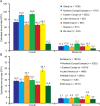Rates and predictors of hypoglycaemia in 27 585 people from 24 countries with insulin-treated type 1 and type 2 diabetes: the global HAT study
- PMID: 27161418
- PMCID: PMC5031206
- DOI: 10.1111/dom.12689
Rates and predictors of hypoglycaemia in 27 585 people from 24 countries with insulin-treated type 1 and type 2 diabetes: the global HAT study
Abstract
Aims: To determine the global extent of hypoglycaemia experienced by patients with diabetes using insulin, as there is a lack of data on the prevalence of hypoglycaemia in developed and developing countries.
Methods: This non-interventional, multicentre, 6-month retrospective and 4-week prospective study using self-assessment questionnaire and patient diaries included 27 585 patients, aged ≥18 years, with type 1 diabetes (T1D; n = 8022) or type 2 diabetes (T2D; n = 19 563) treated with insulin for >12 months, at 2004 sites in 24 countries worldwide. The primary endpoint was the proportion of patients experiencing at least one hypoglycaemic event during the observational period.
Results: During the prospective period, 83.0% of patients with T1D and 46.5% of patients with T2D reported hypoglycaemia. Rates of any, nocturnal and severe hypoglycaemia were 73.3 [95% confidence interval (CI) 72.6-74.0], 11.3 (95% CI 11.0-11.6) and 4.9 (95% CI 4.7-5.1) events/patient-year for T1D and 19.3 (95% CI 19.1-19.6), 3.7 (95% CI 3.6-3.8) and 2.5 events/patient-year (95% CI 2.4-2.5) for T2D, respectively. The highest rates of any hypoglycaemia were observed in Latin America for T1D and Russia for T2D. Glycated haemoglobin level was not a significant predictor of hypoglycaemia.
Conclusions: We report hypoglycaemia rates in a global population, including those in countries without previous data. Overall hypoglycaemia rates were high, with large variations between geographical regions. Further investigation into these differences may help to optimize therapy and reduce the risk of hypoglycaemia.
Keywords: HAT study; diabetes; global; hypoglycaemia; insulin; observational.
© 2016 The Authors. Diabetes, Obesity and Metabolism published by John Wiley & Sons Ltd.
Figures



References
-
- Leiter LA, Boras D, Woo VC. Dosing irregularities and self‐treated hypoglycemia in type 2 diabetes: results from the Canadian cohort of an international survey of patients and healthcare professionals. Can J Diabetes 2014; 38: 38–44. - PubMed
-
- Horvath K, Jeitler K, Berghold A et al. Long‐acting insulin analogs vs. NPH insulin (human isophane insulin) for type 2 diabetes mellitus. Cochrane Database Syst Rev 2007: Apr 18;(2):CD005613. - PubMed
Publication types
MeSH terms
Substances
LinkOut - more resources
Full Text Sources
Other Literature Sources
Medical

